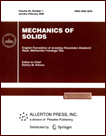 | | Mechanics of Solids
A Journal of Russian Academy of Sciences | | Founded
in January 1966
Issued 6 times a year
Print ISSN 0025-6544
Online ISSN 1934-7936 |
Archive of Issues
| Total articles in the database: | | 13362 |
| In Russian (Èçâ. ÐÀÍ. ÌÒÒ): | | 8178
|
| In English (Mech. Solids): | | 5184 |
|
| << Previous article | Volume 60, Issue 4 / 2025 | Next article >> |
| Zhanfan Chunyu, Zhiwu Zhu, Yue Ma, Tao Li, and Zhengqiang Cheng, "Split Hopkinson Pressure Bar Experiment and Distinct Element Research on Frozen Soil under Passive Confining Pressure," Mech. Solids. 60 (4), 2631-2647 (2025) |
| Year |
2025 |
Volume |
60 |
Number |
4 |
Pages |
2631-2647 |
| DOI |
10.1134/S0025654425601247 |
| Title |
Split Hopkinson Pressure Bar Experiment and Distinct Element Research on Frozen Soil under Passive Confining Pressure |
| Author(s) |
Zhanfan Chunyu (Sichuan Province Key Laboratory of Advanced Structural Materials Mechanical Behavior and Service Safety, School of Mechanics and Aerospace Engineering, Southwest Jiaotong University, Chengdu, 610031 China)
Zhiwu Zhu (Sichuan Province Key Laboratory of Advanced Structural Materials Mechanical Behavior and Service Safety, School of Mechanics and Aerospace Engineering, Southwest Jiaotong University, Chengdu, 610031 China; High-end Equipment Advanced Materials and Manufacturing Technology Laboratory, Chengdu, 610031 China, zzw4455@163.com)
Yue Ma (Chongqing Architectural Design Institute Co., Ltd., Chongqing, China)
Tao Li (Sichuan Province Key Laboratory of Advanced Structural Materials Mechanical Behavior and Service Safety, School of Mechanics and Aerospace Engineering, Southwest Jiaotong University, Chengdu, 610031 China;High-end Equipment Advanced Materials and Manufacturing Technology Laboratory, Chengdu, 610031 China)
Zhengqiang Cheng (Sichuan Province Key Laboratory of Advanced Structural Materials Mechanical Behavior and Service Safety, School of Mechanics and Aerospace Engineering, Southwest Jiaotong University, Chengdu, 610031 China; High-end Equipment Advanced Materials and Manufacturing Technology Laboratory, Chengdu, 610031 China) |
| Abstract |
Frozen soil is a common geological material, and blasting engineering and infrastructure
construction are often conducted on cold regions. However, it is difficult to experimentally analyze
crack development and quantify the evolution of damage in frozen soil that has been simultaneously
subjected to axial impact loading and passive confining pressure. Thus, this study quantitatively evaluated the fractures and evolution of impact damage in frozen soil under passive confining pressure
using numerical simulation. The Split Hopkinson Pressure Bar was used to conduct an impact experiment on frozen soil under passive confining pressure. Subsequently, numerical simulation modeling
of the impact experiment was established using Particle Flow Code 3D and Fast Lagrangian Analysis
of Continua 3D. When the frozen soil was simultaneously subjected to passive confining pressure and
impact loading, the position and number of cracks were analyzed based on the results obtained numerically. The model and contact parameters could predict the mechanical response of the frozen soil.
The evolution of the impact damage with strain in the frozen soil was found to agree with the Weibull
distribution. Furthermore, the impact damage in the frozen soil was extremely low even during the initial stage of plasticity, and the strain threshold of the damage was 0.5%. |
| Keywords |
Impact loading, Axial, Confining pressure, Crack development, Damage |
| Received |
15 March 2025 | Revised |
07 May 2025 | Accepted |
14 May 2025 |
| Link to Fulltext |
|
| << Previous article | Volume 60, Issue 4 / 2025 | Next article >> |
|
 If you find a misprint on a webpage, please help us correct it promptly - just highlight and press Ctrl+Enter If you find a misprint on a webpage, please help us correct it promptly - just highlight and press Ctrl+Enter
|
|

 Russian
Russian  English
English